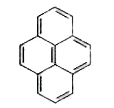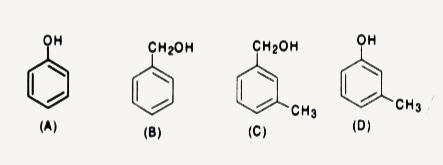In which of the following compound electrophilic aromatic substitution take place in phenyl ring present in left hand side ?




The correct Answer is:D
To determine which compound allows for electrophilic aromatic substitution (EAS) to occur on the phenyl ring present on the left-hand side, we need to analyze the substituents attached to the aromatic rings in each option. Here’s a step-by-step solution:
Step 1: Understand Electrophilic Aromatic Substitution (EAS)
Electrophilic aromatic substitution occurs when an electrophile attacks an aromatic ring. The reaction is favored by electron-rich aromatic systems, as they can stabilize the positive charge that develops during the reaction.
Step 2: Identify Electron-Donating and Electron-Withdrawing Groups
- Electron-Donating Groups (EDGs): These groups increase the electron density of the aromatic ring, making it more reactive towards electrophiles. Common EDGs include -OH, -OCH₃, -NH₂, etc.
- Electron-Withdrawing Groups (EWGs): These groups decrease the electron density of the aromatic ring, making it less reactive towards electrophiles. Common EWGs include -NO₂, -CN, -COOH, etc.
Step 3: Analyze Each Compound
Let’s consider the four options one by one:
1. Option 1: Contains an electron-donating group on the left ring and an electron-withdrawing group on the right ring. The left ring becomes electron-rich, but the right ring is more electron-rich due to the EDG. EAS will occur on the right ring.
2. Option 2: Similar to option 1, the left ring has an EDG, but the right ring is more electron-rich. EAS will occur on the right ring.
3. Option 3: Again, the left ring has an EDG, while the right ring is more electron-rich. EAS will occur on the right ring.
4. Option 4: The left ring has an electron-withdrawing group, making it electron-deficient, while the right ring has an EDG, making it electron-rich. In this case, the left ring is more electron-rich than the right ring due to the presence of the EDG on the left ring, allowing EAS to occur on the left ring.
Step 4: Conclusion
Based on the analysis, the only compound where electrophilic aromatic substitution occurs on the left-hand side phenyl ring is Option 4.
Final Answer
Option 4 is the correct choice where electrophilic aromatic substitution takes place in the phenyl ring present on the left-hand side.
---
Electrophilic aromatic substitution occurs when an electrophile attacks an aromatic ring. The reaction is favored by electron-rich aromatic systems, as they can stabilize the positive charge that develops during the reaction.
- Electron-Donating Groups (EDGs): These groups increase the electron density of the aromatic ring, making it more reactive towards electrophiles. Common EDGs include -OH, -OCH₃, -NH₂, etc.
- Electron-Withdrawing Groups (EWGs): These groups decrease the electron density of the aromatic ring, making it less reactive towards electrophiles. Common EWGs include -NO₂, -CN, -COOH, etc.
Let’s consider the four options one by one:
2. Option 2: Similar to option 1, the left ring has an EDG, but the right ring is more electron-rich. EAS will occur on the right ring.
Based on the analysis, the only compound where electrophilic aromatic substitution occurs on the left-hand side phenyl ring is Option 4.
Option 4 is the correct choice where electrophilic aromatic substitution takes place in the phenyl ring present on the left-hand side.
Similar Questions
Knowledge Check
- Question 1 - Select One or More
Which of the following compounds are aromatic ?
A B
B C
C D
D
- Question 2 - Select One
Which of the following will not undergo nucleophilic aromatic substitution ?
 AI, II and IIIBII and IVVCIII and IVDonly IV
AI, II and IIIBII and IVVCIII and IVDonly IV - Question 3 - Select One or More
Which of the following compounds exhibit aromatic character?
A B
B C
C D
D
Which of the following compounds is aromatic alcohol ?
 View Solution
View SolutionWhich of the following compound is not aromatic?
 View Solution
View SolutionWhich of the following compounds is most reactive in electrophilic aromatic substitution?
View SolutionWhich of the following compounds is not aromatic ?
View SolutionWhich of the following compounds is not aromatic ?
View Solution

